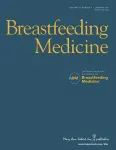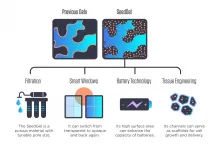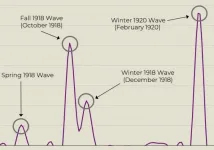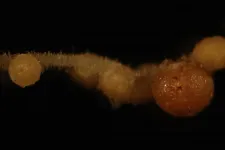(Press-News.org) UNIVERSITY PARK, Pa. -- The descriptions on the fronts of infant and toddler food packages may not accurately reflect the actual ingredient amounts, according to new research. The team found that vegetables in the U.S. Department of Agriculture's "dark green" category were very likely to appear in the product name, but their average order in the ingredient list was close to fourth. In contrast, juice and juice concentrates that came earlier on the ingredient list were less likely to appear in product names.
"Early experiences with food can mold children's preferences and contribute to building healthful, or unhealthful, eating habits that last a lifetime," said author Alyssa Bakke, staff sensory scientist, Penn State. "Our previous work found combining vegetables with fruits reduced the amount of vegetable flavor adults perceived, as the fruit flavors were more pronounced. Other research has also indicated that parents predominantly use front-of-package information to make purchasing decisions. This means that when children are given commercial foods, they may be receiving less exposure to vegetable flavors than their parents assume based on the way the products are labeled and marketed."
The team created a database of over 500 commercial infant and toddler foods containing vegetables and documented inclusion of each vegetable and fruit in the product name; the form of the vegetable or fruit -- such as whole, puree, juice or juice concentrate -- and the position of the vegetable or fruit in the ingredient list. The researchers classified the vegetables based on the Department of Agriculture's categories--Dark Green, Red/Orange, Legumes, Starchy and Other. They classified the fruits into two categories: Common Fruits, comprising pears, apples and grapes, and Other Fruits, including mangos, pineapples and cherries.
The team conducted statistical analyses to examine associations between: (1) vegetable and fruit category and inclusion in front-of-package product name; (2) vegetable and fruit form and inclusion in front-of-package product name; and (3) vegetable and fruit form and inclusion in front-of-package product name, by vegetable and fruit category.
"There was never an instance in which a vegetable or a fruit listed in the product name did not appear in the ingredient list," said John Hayes, professor of food science, Penn State. "However, we still observed a disconnect between product names and ingredient lists. The front-of-pack labels did not always accurately represent the amount of various ingredients in the product, which are listed in descending order. This means parents may not be buying what they are hoping to buy if they only look at the name."
Specifically, the team found that dark green vegetables were more likely than expected to appear in product names; yet, their average order in the ingredient list was close to fourth. Interestingly, the team found that common fruits were less likely than expected to be included in the product names when found as juice/juice concentrates, but more likely than expected to be included in product names when no form was listed.
"Fruit juice and fruit juice concentrates were found in almost all of the food products we examined, but were often excluded from product names, presumably to avoid drawing attention to the use of juice concentrates as sweeteners," said Mackenzie Ferrante, graduate student, Colorado State University, and lead author on the paper.
Ferrante added that in the ingredient lists, fruits tended to be positioned close to the beginning of the ingredient list on the back or side of the package, indicating that the products were composed more of fruits than the vegetables suggested by front-of-package labeling.
"Companies producing infant and toddler foods sometimes use nutrition-related statements that can confuse the consumer and are intended to sway consumers to purchase their product," said Susan Johnson, professor of pediatrics at the University of Colorado Anschutz Medical Campus. "Parents believe vegetables are important for their children's health and that presumably they are purchasing food they believe contain significant amounts of vegetables because of front-of-package labeling. The discrepancies between which foods are included in the product name, where these foods fall on the ingredient lists, and whether these products actually taste like vegetables are key concerns to communicate to parents."
INFORMATION:
The team's findings published on Feb. 8 in the Journal of Nutrition Education and Behavior.
Other authors on the paper include Laura Bellows, associate professor of food science and human nutrition, Colorado State University, and Kameron Moding, assistant professor of human development and family studies, Purdue University.
New Rochelle, NY, February 10, 2021--It may be safe for COVID-infected mothers to maintain contact with their babies. Keeping them apart can cause maternal distress and have a negative effect on exclusive breastfeeding later in infancy, according to The COVID Mothers Study published in the peer-reviewed journal Breastfeeding Medicine. Click here to read the article now.
In this worldwide study, infants who did not directly breastfeed, experience skin-to-skin care, or who did not room-in within arms' reach of their mothers were less likely to be exclusively breastfed in the first 3 months of life. Nearly 60% of ...
Oil and water may not mix, but adding the right nanoparticles to the recipe can convert these two immiscible fluids into an exotic gel with uses ranging from batteries to water filters to tint-changing smart windows. A new approach to creating this unusual class of soft materials could carry them out of the laboratory and into the marketplace.
Scientists at the National Institute of Standards and Technology (NIST) and the University of Delaware have found what appears to be a better way to create these gels, which have been an area of intense research focus for more than a decade. ...
SAN ANTONIO -- Humans possess a formidable multi-layered defense system that protects us against viral infections. Better understanding of these defenses and the tricks that viruses use to evade them could open novel avenues for treating viral infections and possibly other diseases.
For example, a human protein called SAMHD1 impedes replication of the human immunodeficiency virus (HIV) and other viruses by depleting deoxynucleotides -- building blocks needed for the replication of the viral genome. It has long remained a mystery whether and how this protein is activated in response to infection.
Now researchers from The University of Texas Health Science Center at San Antonio (UT Health San Antonio) have discovered that SAMHD1 recognizes a unique molecular ...
Sawfish have disappeared from half of the world's coastal waters and the distinctive shark-like rays face complete extinction due to overfishing, according to END ...
EAST LANSING, Mich. - The 1918 influenza pandemic provides a cautionary tale for what the future may hold for COVID-19, says a Michigan State University researcher.
After a decade studying a flu virus that killed approximately 15,000 Michigan residents, Siddharth Chandra, a professor in MSU's James Madison College, saw his research come to life as he watched the spread of the COVID-19 pandemic.
"It was so surreal," said Chandra, who has a courtesy appointment in epidemiology and biostatistics. "All of a sudden, I was living my research."
Chandra's research is published in the American Journal of Public Health with co-authors Julia Christensen, a graduate of James Madison College; Madhur Chandra, Senior ...
A team of astronomers, including associate professor Chad Trujillo of Northern Arizona University's Department of Astronomy and Planetary Science, have confirmed a planetoid that is almost four times farther from the Sun than Pluto, making it the most distant object ever observed in our solar system. The planetoid, which has been nicknamed "Farfarout," was first detected in 2018, and the team has now collected enough observations to pin down its orbit. The Minor Planet Center has now given it the official designation of 2018 AG37.
Farfarout's nickname distinguished it from the previous record holder "Farout," found by the same team of astronomers ...
Orange, Calif. - The mutually beneficial relationship between legumes and rhizobia, the nitrogen-fixing soil bacteria that make their home in legume root nodules and create nutrient-rich fertilizer for them, is one of the most well-known and agronomically important examples of symbiosis. New research from END ...
Individual choices in medicine carry a certain amount of uncertainty.
An innovative partnership at The University of Texas at Austin takes aim at medicine down to the individual level by applying state-of-the-art computation to medical care.
"Medicine in its essence is decision-making under uncertainty, decisions about tests and treatments," said Radek Bukowski, MD, PhD, professor and associate chair of Investigation and Discovery in the Department of Women's Health at Dell Medical School at UT Austin.
"The human body and the healthcare system are complex systems made of ...
Firefighters and emergency medical services workers are at high risk of exposure to COVID-19 while on the job and pose an additional risk of transmitting the virus to others. Although vaccines are a promising public health tool for reducing COVID-19 transmission, little has been known about the perceptions of the COVID-19 vaccine among first responders.
To provide insight, a University of Miami Miller School of Medicine-led study queried a national sample of U.S. firefighters and emergency medical services workers through an anonymous online survey. The study results, published online Feb. 1 in the Journal of Occupational ...
Ten years ago, researchers at Aarhus University, Denmark, reported the discovery of centimeter-long cable bacteria, that live by conducting an electric current from one end to the other. Now the researchers document that a few cells operate with extremely high oxygen consumption while the rest of the cells process food and grow without oxygen. An outstanding way of life.
We humans need food and oxygen to live.
Now, imagine if oxygen was to be found only at the mountain top and food only in the valley. That's how the world looks like for cable bacteria, which live in the bottom of seas and lakes. For them, ...






